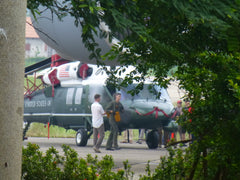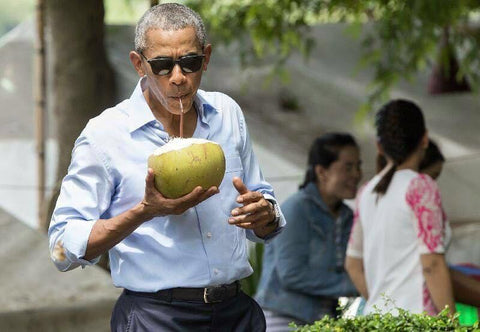U.S. President Barack Obama's 2016 Visit to Luang Prabang
On September 6, 2016, U.S. President Barack Obama made history as the first U.S. president to visit Laos. He spoke in the capitol city Vientaine and traveled to Luang Prabang the following day.
Our volunteers at the JungleVine® center, located just 500 meters from the Luang Prabang International Airport, witnessed several United States Air Force C-17 equipment and personnel transport deliveries in preparation for Obama's visit.






We theorized that Obama might address the unexploded ordnance (UXO) dropped during the Vietnam War that contaminates the Lao countryside and continues to injure and kill. We were right. On September 6, 2016, Obama acknowledged what had been called the 'Secret War' and committed to increase funding to clean up the deadly UXOs. Following the summit in the capitol city Vientaine, he traveled to Luang Prabang to hold a town hall meeting with the Young Southeast Asian Leaders Initiative (YSEALI).
During the YSEALI meeting, President Obama twice talked about how selling handicrafts can help indigenous people. Early in his speech at Souphanouvong University, he said, "My mother worked in Southeast Asia most of her life, working with women in villages to try to help them get more money through selling handicrafts and developing small businesses." Later, he talked about Mimi Sae-Ju, who "founded the Lisu Cultural Heritage Center in Chaing Mai (Thailand) to promote and preserve the indigenous history of her people. She sells handicrafts made by Lisu women, which helps them earn a living and makes sure that their culture lives on in future generations."
These comments strike a chord with us at the JungleVine® Foundation, as our missions are so similar, only serving a different indigenous group, the Khmu.



Sipping juice from a fresh coconut and enjoying his time in Luang Prabang.

President Obama steps off Air Force One in Luang Prabang.



President Obama waves to one of our volunteers as his car goes through the airport gate on the way to the Wat.
We've got exclusive video footage of the presidential motorcade going to and from Souphanouvong University. The Lao police and army were incredibly thorough in providing security during Obama's visit. They were also extremely kind and friendly whenever members of the public needed to be rerouted.


C-17s load up for the return trip to the U.S. following President Obama's historic visit.
*If our images are used, please give credit to JungleVine® Foundation.
Unique Perspective on Obama's Luang Prabang Visit
It was November 1972 when two young Americans found their way to a then little-known cultural treasure in northern Laos that had been the center of a mighty kingdom centuries before. Following notes handwritten by an American Peace Corps volunteer, they discovered beautiful temples, a nearly abandoned royal palace, and a “secret” war underway in the ancient royal capital of Luang Prabang.
On September 6, 2016, U.S. President Barack Obama’s Air Force One touched down at the same airport from which American gunships launched their clandestine nighttime attacks on soldiers of the Pathet Lao revolutionary group more than four decades before. Obama’s predecessors, Kennedy and Johnson, had consistently denied American involvement in this civil conflict. Obama was the first U.S. president to acknowledge what the two young Americans had seen in their three-day visit nearly 44 years earlier.
The JungleVine® Foundation, an Iowa, U.S.-based public charity, has a research retreat and the global headquarters for its mission in a teak wood forest less than 300 meters from where Obama stepped off his plane. What follows is a unique perspective of Obama’s historic visit in the context of what the two young Americans had experienced on their adventure years earlier. It is made possible because of the Foundation’s presence at the airport, which gave access to close-up views of the logistics involved in bringing the first visit of an American president.

Obama’s plan to meet with Asian leaders in the Lao capital Vientiane was widely known for months in advance. Today, Vientiane is a half-hour flight, an 8- to 12-hour car or bus ride, or a 2- to 3-day boat ride on the mighty Mekong River from Luang Prabang. Because there was no road in 1972 and the Pathet Lao controlled the river corridor, the young Americans used the daily Royal Air Lao flight of a seasoned Lockheed Electra to travel over the mountainous tree-covered terrain. They saw frequent small lakes in the flatter areas—bomb craters that had filled with water.
The first indications that Obama would make a journey to Luang Prabang were the appearance of unusual guests at the eco-friendly Luang Prabang View Hotel in late August. Muscular, English-speaking young men with short military-like haircuts frequently lounged around the sky pool and worked out in the gym. Although Luang Prabang attracts large numbers of diverse visitors, these guys stood out from ordinary tourists.
Shortly thereafter, locals began posting on Facebook, mentioning the possibility of a visit from the U.S. president. At a boat racing festival on the Nam River, local air traffic controllers said they had been told Obama would be coming to Luang Prabang and that they would be assisted on the job by an American.
Then, shortly after 2 p.m. on Saturday, August 27, the largest aircraft ever seen near the ground in northern Laos made a hard-to-miss, seemingly slow approach from the west, directly over the town, its four large engines roaring and landing lights blazing. It was a C-17, the second largest cargo carrier in the U.S. Air Force fleet. Several hours later, its take-off to the west over streets filled with students going home from school was even more striking. Although Lao people are not easily excited, the arrival and departure of that first C-17 brought lots of excitement all over Luang Prabang.
To be continued… please visit again, as we will add more to this story.
Our Coverage as News of Obama's Visit Began to Unfold
Luang Prabang, Laos. Saturday, August 27, 2016 – history was made this afternoon shortly after 2:00 when a massive U.S. Air Force cargo ship approached from the west and landed at the international Airport here. It was the first U.S. military flight to this ancient Royal Capitol since the U.S.’s “Secret War” in the 1960s and 70s.
By far the largest aircraft ever to land here, instead of carrying weapons of war, this plane held equipment needed for the first ever visit by a U.S. President to this landlocked country of fewer than seven million. Barack Obama plans to stop here during his trip to China and the Asian summit in the Lao capitol Vientiane September 6 – 10.
The Boeing C-17 Globemaster III was a striking contrast to the so-called spook gunships used clandestinely to drop aerial flares lighting up the nearby countryside and shooting tracer bullets at Phatet Lao soldiers 40+ years ago. Although the rebel army controlled virtually all of northern Laos, Luang Prabang was never attacked, saving it from what would’ve been significant damage. As a result, Luang Prabang now is a UNESCO protected world heritage site because of the Royal Palace, magnificent ancient Buddhist temples, epicurean dining and maintained traditional lifestyles that make it one of the world’s best tourist destinations.
Although this is the same airport, it has been rebuilt twice since the days of the secret war during which the CIA’s Air America transports made dozens of stops a week carrying war materials, personnel and reportedly opium and marijuana between more remote areas in the north. The second of the passenger terminal buildings now is used by the Lao military, and it was on its ramp that the giant cargo carrier parked. For the next two hours, tons of vehicles and equipment were offloaded into a fleet of a dozen Lao trucks.
Less than 500 feet away at the JungleVine® Retreat the 30-year-old Anousith Phonethasith, Managing Partner of social enterprise Lao JungleVine® Development Co. Ltd., was guiding a teambuilding session with two of his partners. The JungleVine® Retreat is hidden in a predominantly teak wood forest and provided by the JungleVine® Foundation to the Lao social enterprise as a conference center and agriculture research area.
“Wow, this is so exciting,” said an obviously elated Phonethasith. “We’ve been reading on Facebook over the last couple of days that Obama was going to visit our town, but because we did not know why, it was hard to believe.”
There has been no announcement from the White House or the American Embassy in Laos that Obama will visit Luang Prabang. However, reliable sources report that he will lead a two-hour session of the Young Southeast Asian Leaders Initiative here after attending the Asian summit in Vientiane.
During the Vietnam War era, the U.S. dropped more than 2 million tons of bombs on Laos, despite the fact that Laos was not participating in the war. (Presidents Kennedy and Johnson both acknowledged that fact.) That equates to dropping an entire planeload of bombs every 8 minutes, 24 hours a day, for nine years. An estimated 30 percent of those bombs failed to detonate on impact, leaving much of the Lao countryside severely contaminated with unexploded ordnance (UXO). http://legaciesofwar.org/about-laos/secret-war-laos/
“We would be surprised if President Obama is coming here to apologize for what America did, and most of us would not expect that,” said Phonethasith speculating about the purpose of this historic visit. “However, his choice to visit Luang Prabang in northern Laos in the area where the war was centered surely has some significance. Perhaps he will at least acknowledge what occurred so that the American war in Laos no longer is an official secret.”
_____________________________________
The JungleVine® Foundation is an Iowa U.S.A.-based public charity under section 501(c)(3) of the tax code. It has formed and has a close affiliation with Lao JungleVine® Production Promotion Co. Ltd., chartered by the Lao Ministry of Agriculture and Forestry. Their mission is to reduce poverty in northern Laos, mitigate global climate change by promoting the use of amazing wild growing JungleVine® and preserve an ancient craft through linking the indigenous Khmu tribe with the global community. It offers homemade by hand Earth’s Greenest Bag as well as cleaning and exfoliation products at www.NatureBag.ORG and retailers in 25 countries.
Contact service@junglevine.org for reproduction authorization as well as additional information.
Copyright© 2021 the JungleVine® Foundation
all rights reserved





